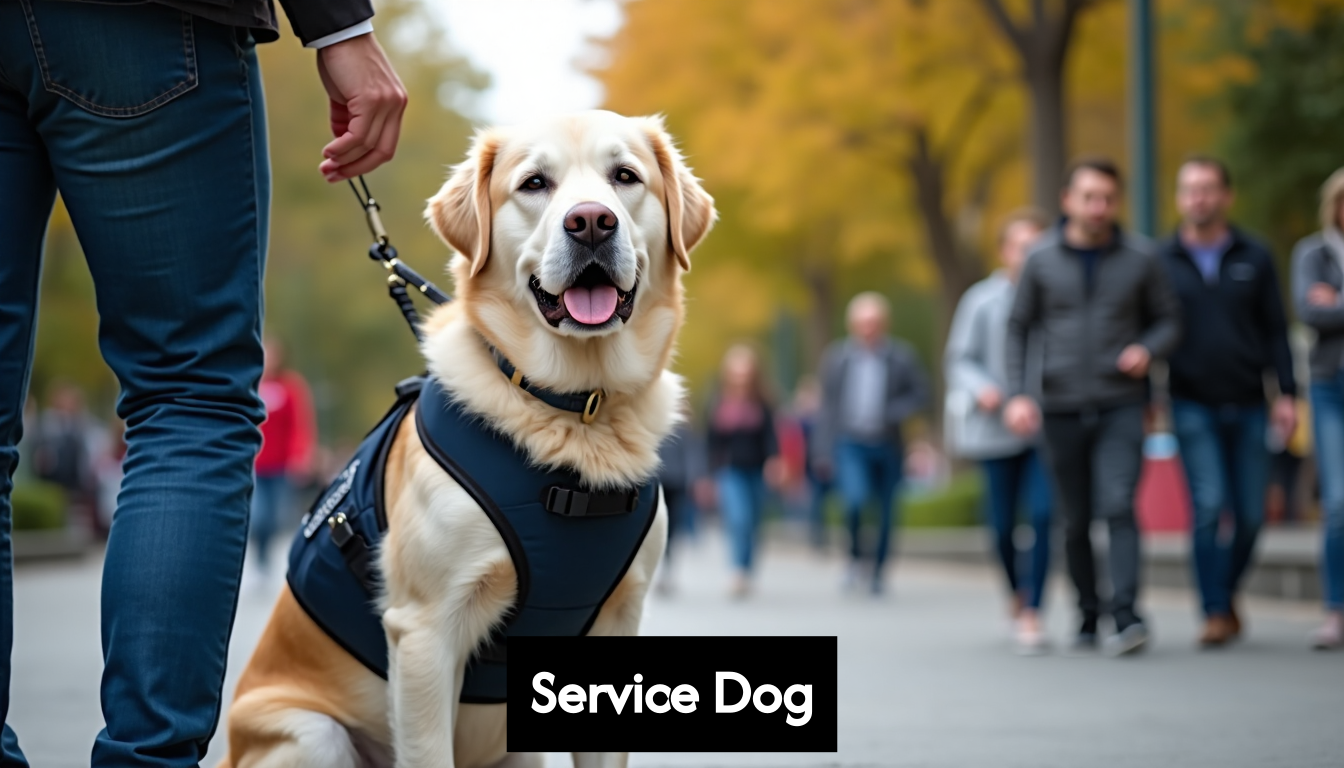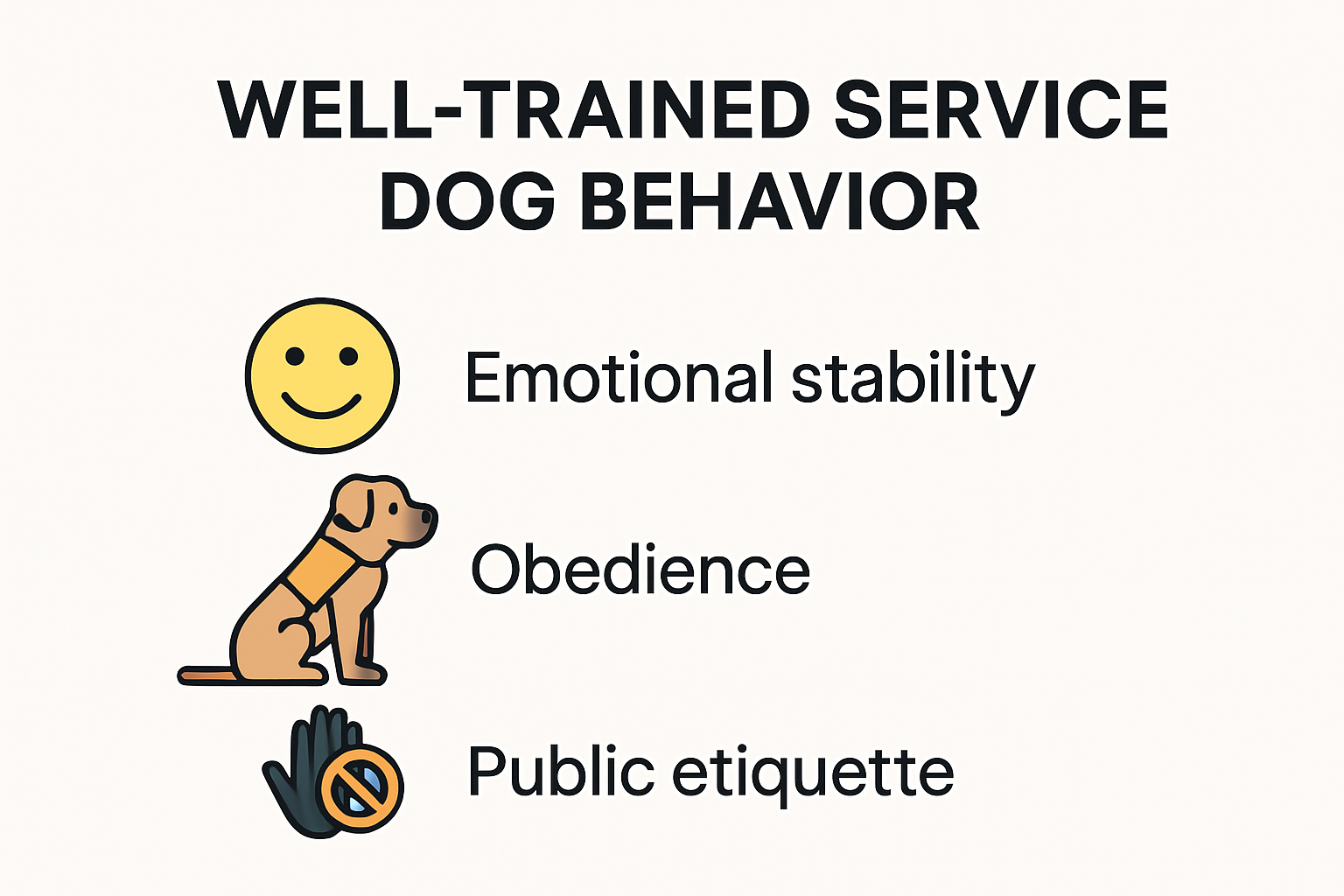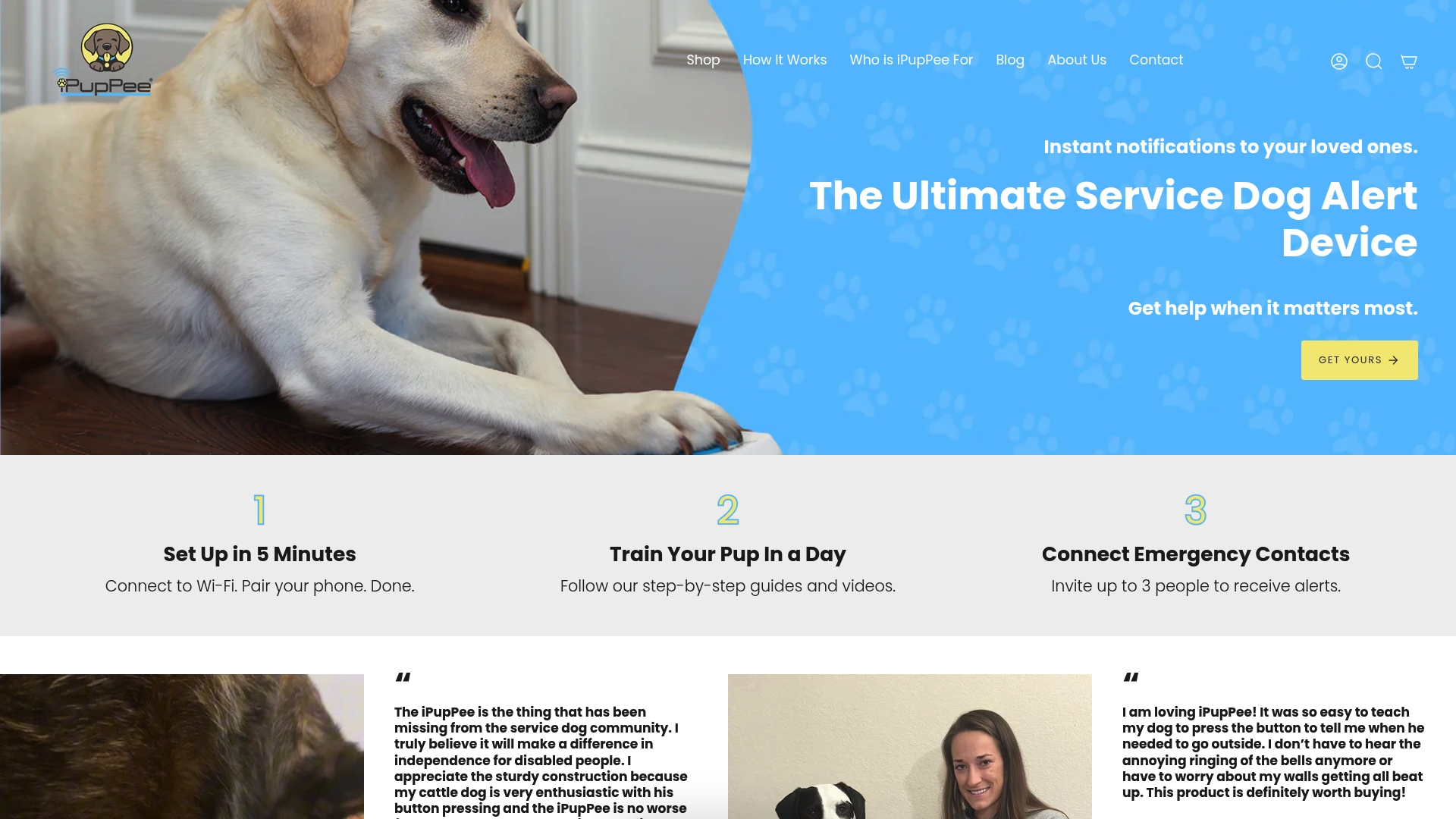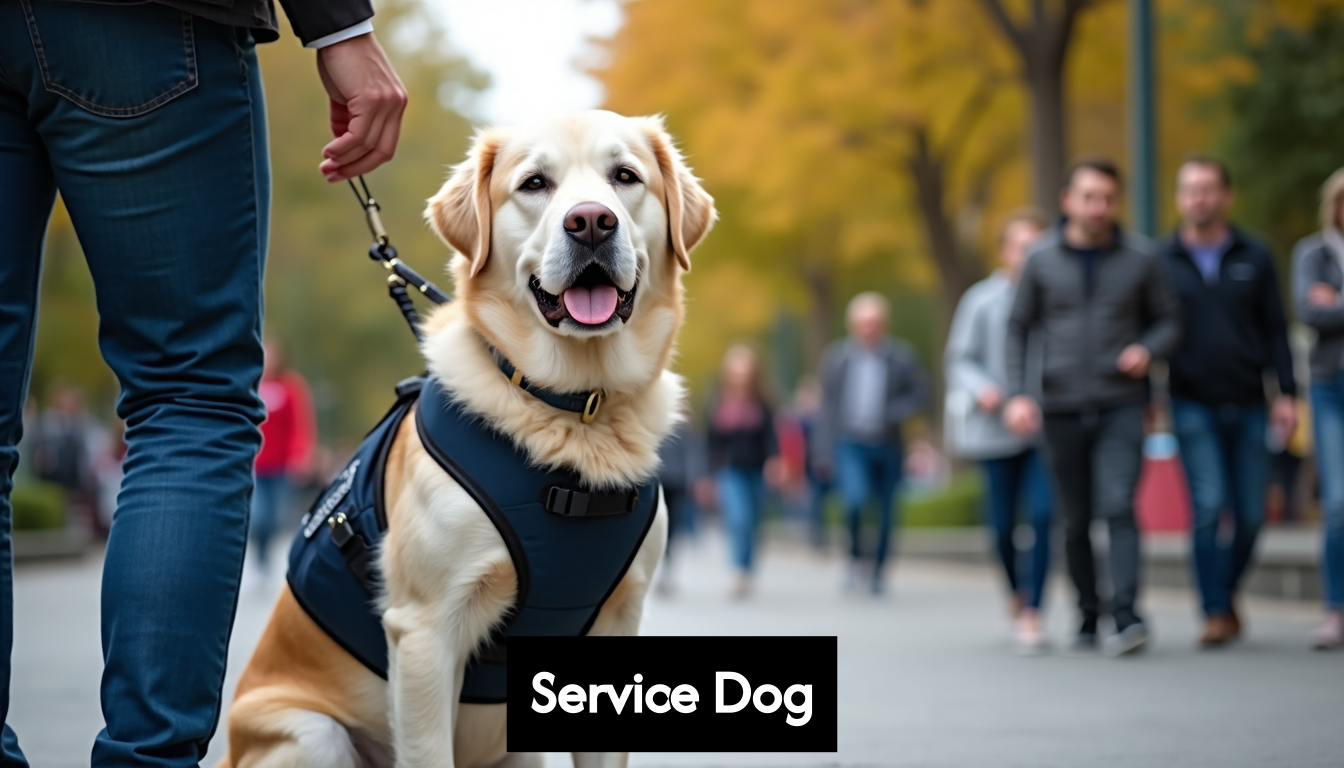
Service dogs aren’t just well-behaved pets—they’re rigorously trained partners that transform lives every day. Here is something most people never realize. Fifty to seventy percent of dogs selected for service training never make it through the program because the standards are so high. Emotional stability, reliable obedience and seamless public behavior are just the beginning and what separates a true service dog from the rest might surprise you.
Table of Contents
- Key Traits Of Well-Trained Service Dogs
- What To Expect In Public Environments
- Common Behavior Challenges And Solutions
- How Handlers And Trainers Can Shape Behavior
Quick Summary
| Takeaway | Explanation |
|---|---|
| Emotional Stability is Crucial | A well-trained service dog must maintain composure and emotional balance to focus on the handler’s needs, particularly in stressful or distracting environments. |
| Obedience and Task Proficiency are Essential | Service dogs need to master core commands and specialized tasks to ensure their handler’s safety and independence, requiring precise execution and understanding of context. |
| Handlers Play a Key Role | Service dog handlers must effectively communicate, manage public interactions, and maintain consistent routines to support their dog’s behavior and emotional health. |
| Behavioral Challenges can be Managed | Identifying triggers and applying intervention strategies, such as systematic desensitization and positive reinforcement, are critical in addressing potential behavioral issues. |
| Tailored Training is Necessary | Each service dog requires an individualized training approach that considers their unique temperament and needs, promoting continual growth and adaptation. |

Key Traits of Well-Trained Service Dogs
Service dogs represent a critical lifeline for individuals with disabilities, requiring an exceptional set of behavioral characteristics that go far beyond typical pet training. These remarkable animals must demonstrate extraordinary temperament, skills, and reliability in complex environments.

Temperamental Excellence and Emotional Stability
A well-trained service dog’s most fundamental trait is an unshakeable emotional balance. According to service dog training experts, these dogs must maintain composure in challenging situations, displaying a calm demeanor regardless of external stimuli. This emotional stability allows them to focus entirely on their handler’s needs.
Statistics reveal the rigorous selection process behind service dog training. Research shows that 50-70% of potential service dog candidates do not complete their training, underscoring the exceptional qualities required. These dogs must consistently demonstrate:
- Controlled Reactions: Minimal response to unexpected sounds, movements, or distractions
- Emotional Resilience: Ability to remain focused during stressful scenarios
- Adaptive Intelligence: Quick problem solving without emotional escalation
Advanced Obedience and Task Performance
Beyond emotional stability, service dogs require impeccable obedience and specialized task training. Certification standards mandate proficiency in core commands including sit, stay, come, down, heel, and critical work-specific tasks tailored to their handler’s unique needs.
These dogs must execute commands with precision, understanding that their work directly impacts their handler’s safety and independence. This requires not just training, but an intuitive understanding of human communication and environmental context. If you want to explore more about developing these critical skills, our comprehensive service dog training guide offers in-depth insights.
Public Behavior and Social Integration
A distinguishing characteristic of service dogs is their remarkable public behavior. Unlike typical pets, these animals must navigate complex social environments with minimal disruption. They walk calmly beside their handler, ignore other people and animals, and maintain a professional demeanor in restaurants, public transportation, workplaces, and other shared spaces.
This social sophistication requires extensive socialization and training, teaching the dog to be simultaneously hyperaware of their handler’s needs while remaining unobtrusive to surrounding environments. The dog becomes an extension of their handler’s autonomy, providing support without drawing unnecessary attention.
Ultimately, service dogs represent more than trained animals they are highly specialized partners whose behavior reflects years of dedicated training, innate temperamental qualities, and an extraordinary bond with their human companions.
What to Expect in Public Environments
Navigating public spaces with a service dog requires understanding complex social dynamics, legal protections, and professional behavioral expectations. Service dog handlers must be prepared for various scenarios that test their dog’s training and their own communication skills.
Legal Rights and Access Protocols
Legal guidelines clearly outline the expectations for service dogs in public environments. Businesses cannot typically refuse entry to a well-trained service dog, but the dog must demonstrate specific behavioral standards. This means the animal must remain under complete control, avoid disruptive behaviors, and perform its designated support functions without creating unnecessary attention or disturbance.
Key legal considerations include:
- Professional Conduct: Dogs must remain calm and focused on their handler
- Control Standards: Immediate response to handler commands
- Non-Aggressive Behavior: Zero tolerance for growling, barking, or threatening actions
Interestingly, service dog certification experts note that venues retain the right to exclude service dogs that demonstrate uncontrolled or inappropriate behaviors. This underscores the critical importance of consistent, rigorous training.
Behavioral Expectations in Different Settings
Public environments present unique challenges for service dogs. Restaurants, public transportation, workplaces, and retail spaces all require different levels of behavioral adaptation. A service dog must seamlessly transition between these environments while maintaining unwavering focus on their handler’s needs.
For instance, in a restaurant, the dog should:
- Remain quietly positioned under the table
- Ignore food and other distractions
- Stay alert to their handler’s potential medical or mobility requirements
Public transportation adds another layer of complexity. The dog must remain calm amidst crowd movements, loud noises, and confined spaces. Advanced training methodologies now emphasize multi-stage desensitization techniques to prepare dogs for these challenging environments.
Handler Responsibilities and Public Interaction
Service dog handlers play a crucial role in managing public interactions. While the dog’s training is paramount, the handler must also understand appropriate communication strategies. This includes politely addressing potential misunderstandings, educating uninformed individuals about service dog protocols, and maintaining professional boundaries.
Key handler responsibilities include:
- Preventing unnecessary interactions with the service dog
- Explaining the dog’s working status
- Ensuring the dog remains focused on its support tasks
Our comprehensive service dog guide offers additional insights into navigating these complex social dynamics.
Ultimately, successful public navigation requires a seamless partnership between a well-trained service dog and a knowledgeable, considerate handler. The goal is not just access, but demonstrating that service dogs are professional, essential support partners who enhance independence and quality of life.
Common Behavior Challenges and Solutions
Service dogs represent extraordinary companions, but their journey is not without complex behavioral challenges that require strategic intervention and specialized training approaches. Understanding these potential obstacles is crucial for maintaining the dog’s effectiveness and the handler’s quality of life.
Identifying Behavioral Triggers and Responses
Research from assistance dog foundations reveals that only 15-20% of dogs initially selected demonstrate the temperamental qualities necessary for service work. This statistic underscores the critical nature of identifying and addressing potential behavioral challenges early.
Common behavioral triggers typically include:
- Environmental Stressors: Loud noises, crowded spaces, unfamiliar surroundings
- Social Interactions: Unexpected human or animal approaches
- Physical Stimuli: Sudden movements, unusual textures or sensations
Handlers must develop keen observation skills to recognize subtle stress signals that might precede more significant behavioral disruptions. Early recognition allows for immediate redirection and prevents potential escalation.
Specialized Intervention Strategies
Addressing behavioral challenges requires a multifaceted approach. Assistance dog experts emphasize that 43% of service dog handlers encounter access challenges, making consistent training and behavioral management paramount.
Effective intervention strategies include:
- Systematic desensitization training
- Positive reinforcement techniques
- Targeted behavior modification protocols
- Regular professional assessment and training updates
These methods help service dogs maintain composure and focus, even in complex or potentially stressful environments. Our advanced training resources offer comprehensive guidance for handlers seeking detailed intervention techniques.
Psychological Resilience and Handler Support
Behavioral challenges are not solely the dog’s responsibility. Handlers play a critical role in creating a supportive, stable environment that promotes psychological resilience. This involves understanding canine body language, managing the dog’s emotional state, and providing consistent, calm leadership.
Key psychological support techniques include:
- Maintaining predictable routines
- Creating safe training environments
- Implementing stress reduction protocols
- Developing strong communication and trust
Professional trainers recommend ongoing education and periodic reassessment to ensure the service dog remains mentally and emotionally prepared for its critical support role.
Ultimately, addressing behavioral challenges is a collaborative journey between the dog, handler, and professional support network. Success depends on patience, understanding, and a commitment to continuous learning and adaptation.
How Handlers and Trainers Can Shape Behavior
Shaping service dog behavior is a nuanced art that requires scientific understanding, emotional intelligence, and strategic training techniques. Handlers and trainers play a pivotal role in transforming potential canine candidates into reliable, responsive support partners who can navigate complex human environments with precision and empathy.
Scientific Foundations of Behavioral Modification
Modern training approaches emphasize evidence-based techniques rooted in animal behavior psychology. These methods move beyond traditional punishment-based training, focusing instead on understanding canine cognition and motivation.
Key scientific principles include:
- Positive Reinforcement: Rewarding desired behaviors
- Operant Conditioning: Creating clear behavior associations
- Systematic Desensitization: Gradually exposing dogs to potential stressors
Worldwide training trends increasingly highlight the importance of force-free methods that build trust and strengthen the human-canine partnership. These approaches recognize that service dogs learn most effectively through compassionate, consistent guidance.
Communication and Relationship Building
Successful behavior shaping transcends mechanical training techniques. It requires developing a profound communication system between handler and dog. This involves understanding subtle body language, emotional states, and creating an environment of mutual respect and trust.
Effective communication strategies include:
- Consistent verbal and non-verbal cues
- Recognizing and responding to the dog’s stress signals
- Establishing clear boundaries with positive reinforcement
Handlers can explore advanced communication techniques to deepen their understanding of canine emotional intelligence and behavioral responses.
Tailored Training Approaches
No single training method works universally. Each service dog requires a personalized approach that considers their individual temperament, potential work requirements, and specific handler needs. Trainers must remain adaptable, continuously assessing and adjusting techniques to support the dog’s learning and development.
Customization involves:
- Comprehensive temperament assessment
- Identifying individual learning styles
- Developing targeted skill training programs
- Regular performance evaluations
Professional trainers recommend progressive training techniques that evolve with the dog’s capabilities, ensuring continuous growth and adaptation.
Ultimately, shaping service dog behavior is a collaborative journey of mutual understanding, respect, and ongoing learning. Success depends on the handler’s commitment to compassionate, science-based training methods that honor the unique bond between human and canine.
Frequently Asked Questions
What are the key traits of a well-trained service dog?
A well-trained service dog must exhibit emotional stability, advanced obedience, and exceptional public behavior. These traits enable them to effectively support their handlers and navigate various environments without causing disruption.
How can I help my service dog manage behavioral challenges?
To help your service dog manage behavioral challenges, identify triggers early, implement systematic desensitization techniques, and use positive reinforcement strategies. Continued training and awareness of your dog’s emotional state are also essential.
What legal rights do service dogs have in public spaces?
Service dogs are granted access to public spaces under federal law, meaning businesses cannot refuse entry if the dog is well-behaved and trained to assist its handler. The dog must remain under control and not pose a threat to others.
How can I establish effective communication with my service dog?
Effective communication with your service dog involves using consistent verbal and non-verbal cues, recognizing your dog’s stress signals, and establishing clear boundaries through positive reinforcement methods.
Unlock Communication and Confidence with iPupPee
Do you struggle with maintaining your service dog’s focus or wish you could understand their stress signals before issues arise? Service dog owners face real challenges around communication, public behavior, and ensuring their dog’s needs are met in stressful environments. The right support tool can make the difference between uncertainty and reliable teamwork. The “Understanding Service Dog Behavior: 2025 Guide” highlights the crucial need for emotional stability, clear handler signals, and seamless communication—pain points that every service dog handler knows too well.

Imagine bridging the gap between you and your dog, empowering safer and more independent living. The iPupPee alert device is designed with service dog teams and individuals with special needs in mind. With a single button press, your dog can tell you when they need to go out or need help, reducing stress and preventing misunderstandings. Take the next step to improve your partnership—explore how iPupPee empowers communication and safety for working dogs and their people. Make life easier for you and your service dog today—visit our main site and see what’s possible now.

